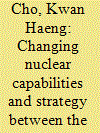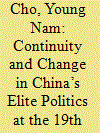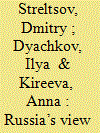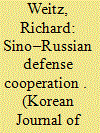|
|
|
Sort Order |
|
|
|
Items / Page
|
|
|
|
|
|
|
| Srl | Item |
| 1 |
ID:
157760


|
|
|
|
|
| Summary/Abstract |
Recent security challenges in East Asia have provided an opportunity to realize the
need for community building as a way of detouring military deadlock. This paper
suggests two principles of community building in East Asia: (1) identity balanced
by interest, and (2) an Asia of citizens beyond an Asia of states. These principles can
be applied to the community building sub-areas of politico–economic, security, and
sociocultural cooperation. The author examines the following topics accordingly:
(a) an invalid concept of the “Asian paradox” and the statement made by Japan’s
prime Minister Shinzo Abe in the politico–economic area; (b) the Helsinki Accord
and the EU Global strategy with their implication for East Asia in the security area;
and (c) the Campus Asia program and the Asian Human Rights Court as a means to
encourage sociocultural cooperation. With its complicated history of animosity and
low levels of intraregional trade, fostering a shared identity and finding common
interests in East Asia is no easy task. If some identities are given and others are
chosen, it is important to manage the negative effects of identity and encourage the
positive influence of its chosen dimensions.
|
|
|
|
|
|
|
|
|
|
|
|
|
|
|
|
| 2 |
ID:
157756


|
|
|
|
|
| Summary/Abstract |
Continuous development of North Korea’s nuclear capabilities and the
accompanying concern about the possible decoupling of the alliance between the
Republic of Korea (ROK) and the United States have produced numerous opinions
on what should be done about North Korea’s nuclear program. While there are
discussions on conceptual possibilities of deterrent or compellent use of nuclear
weapons by North Korea, these discussions often fall short of making specific
connections between the relational nuclear capabilities between North Korea
and the United States, and their nuclear strategies. Such connection is necessary
in grasping a clear picture of the nuclear security environment of the Korean
Peninsula, and formulating possible policy responses the ROK should adopt
as a result. This article seeks to make this connection by analyzing the nuclear
capabilities and strategy of North Korea and the United States. It argues that
North Korea will be able to pressure alliance decoupling only if it is able to field
submarine–based ballistic missiles with an inter-continental range. The ROK should
seek to avoid this outcome by strengthening its own deterrence measures against
North Korea, seeking assurances on the U.S. alliance commitment, and seeking
measures that could reverse North Korea’s potential second–strike capability.
|
|
|
|
|
|
|
|
|
|
|
|
|
|
|
|
| 3 |
ID:
157758


|
|
|
|
|
| Summary/Abstract |
This article analyzes the 19th National Congress of the Chinese Communist
Party (CCP) held in October 2017. It focuses on leadership changes (including
power succession) and revision of the Party Constitution. It tries to answer the
question of whether Xi Jinping’s “one-man rule”, instead of collective leadership,
was established after the Congress. First, it looks at several norms concerning
personnel selection (including the 68 age-limit regulation) that play a critical role
in maintaining collective leadership. Second, it examines to which extent the 19th
Party Congress upheld these norms. Third, this paper investigates the enshrining of
Xi Jinping Thought in the Party Constitution and the implications with regards to
the changes of elite politics. It argues that the Party Congress followed the norms
relatively well, and that collective leadership still persists. In other words, Xi’s
“one-man rule” is not established yet
|
|
|
|
|
|
|
|
|
|
|
|
|
|
|
|
| 4 |
ID:
157762


|
|
|
|
|
| Summary/Abstract |
The paper analyzes India–Pakistan’s lopsided nuclear deterrence and military
strategies. India plans to deliberately escalate a limited war against Pakistan.
Pakistan is determined to neutralize India’s schema on different planes, a limited
conventional, limited nuclear to strategic nuclear wars. It is destabilizing and
complicating South Asia’s nuclear deterrence matrix. Pakistan’s threshold has
depleted due to its “two-frontal” security dilemma. It has considerably increased
Pakistan’s reliance on nuclear weapons. It is deduced that, India–Pakistan’s
inflexible and egocentric cultural mooring is inhibiting them from stepping back
from perilous military strategies, which can trigger miscalculations, enhance
misperceptions, or may lead to the outbreak of accidental/inadvertent limited
conventional or nuclear war. Both countries need to recognize the imperative of a
stable nuclear deterrence and peaceful coexistence instead of crafting unpredictable
and dangerous strategies. The shared risks of nuclear catastrophe should motivate
them to pursue rational and realistic policies.
|
|
|
|
|
|
|
|
|
|
|
|
|
|
|
|
| 5 |
ID:
157761


|
|
|
|
|
| Summary/Abstract |
The article focuses on Russia’s approach to international security in Northeast Asia.
It argues that Russia’s unique position is that it is not a party of any major security–
political conflict, takes a neutral position on territorial conflicts as best suiting its
interests of promoting cooperation with all East Asian states and objects to the
involvement of third parties. Russia is involved only in a dispute with Japan where
it demonstrates a flexible position. As a comparatively weak regional player, Russia
is interested in maintaining peace, stability and the status quo, in particular on the
Korean Peninsula, and has no revisionist agenda in East Asia. Major elements of
Russia’s approach include creating an inclusive, open, transparent and equitable
regional security architecture, support for polycentric regional order with Russia
as one of the major centers of power, criticism of the U.S.–sponsored MBD as
well as focus on a strategic partnership with China. Intensifying its Asian pivot,
Moscow is increasingly concerned with the tensions on the Korean Peninsula
where it promotes denuclearization, dialogue between the two Koreas, resumption
of the Six–Party Talks and opposes to the dangerous actions of all parties. Russia
and China advocate a “moratorium for a moratorium” proposal as the only way to
mitigate tensions and create a common security mechanism.
|
|
|
|
|
|
|
|
|
|
|
|
|
|
|
|
| 6 |
ID:
157757


|
|
|
|
|
| Summary/Abstract |
The strengthening Sino–Russian defense partnership has complicated ROK–U.S.
military planning regarding North Korea, diverted U.S. and Japanese resources from
concentrating against North Korea, and worsened the regional security environment
by stimulating local arms races. Beijing and Moscow’s vigorous opposition to the
deployment of advanced U.S. missile defenses in South Korea has illuminated
their perception of increased ROK–U.S. military ties as a potential threat. Further,
China and Russia’s military activities around the Korean Peninsula increase the risk
of inadvertent encounters with other navies. South Korea, Japan, and the United
States need to consider how China and Russia will react in such cases. Additionally,
because the expanding Sino–Russian defense cooperation and technology sharing
complicates assessments of military developments and security trends in Asia, it is
imperative to hold expanded ROK–U.S. consultations, about Sino–Russian defense
interactions, ideally with the inclusion of Japan.
|
|
|
|
|
|
|
|
|
|
|
|
|
|
|
|
| 7 |
ID:
157759


|
|
|
|
|
| Summary/Abstract |
Does President Donald J. Trump have a coherent statecraft? Can we find a
consistent grand strategy in this new administration, worth calling the “Trump
Doctrine”? Mainly supported by angry Jacksonian folks who have been frustrated
with economic polarization and racial anxiety, Trump’s foreign policy idea
resonates well with European realism. Considering the fact that realist theory has
been confined to the margins of public discourse in post–Cold War America, this
unexpected return of the realist doctrine on the U.S. political scene needs to be
explained. Why are we suddenly approaching realism’s moment in foreign policy?
What makes prominent realists express their best wishes to President Trump?
In this article, we focus on the historical parallel between two maverick presidents
in modern U.S. history, Richard Nixon and Donald Trump. In particular, it is argued
that the realities of the United States’ relative decline induced the Nixon and Trump
administrations to embark on an unconventional course of realpolitik in world
politics. The U.S. leadership in the early 1970s strived to adjust to a condition in
which U.S. dominance was no longer as certain as in the early years of the postwar
times by adopting unorthodox statecraft amid profound political polarization.
Seemingly, the same story applies to the present administration. By attacking the
liberal consensus of the establishment, domestic and international, the Trump
government tries to “make America great again” in another era of increased stress.
Confronting an emerging multipolar international system and the collapse of the
existing national consensus, dramatic shifts in policies have been implemented to
ensure that the United States will remain a hegemonic power on the world scene.
|
|
|
|
|
|
|
|
|
|
|
|
|
|
|
|
| 8 |
ID:
157755


|
|
|
|
|
| Summary/Abstract |
Scholars expect that a state possessing nuclear weapons has strong incentives to
proactively attack its non-nuclear adversary rather than allow it to go nuclear. So
why has the United States not already bombed North Korea? This article presents
three different frames through which policymakers evaluate the North Korea
threat—to deterrence, to nuclear nonproliferation, and to regional stability. In each,
preventive strikes play a different primary role, and the article explains the frame–
specific risks that inhere in different “theories” of preventive strikes based on their
intended purpose. The analysis shows that, in the North Korea context, preventive
strikes are a crude and unreliable instrument of policy: any purpose preventive
strikes might serve is put in jeopardy by the strikes themselves. Past U.S. presidents
would have been unlikely to bomb North Korea even if they faced more desperate
circumstances than they did, if only because it would have required assuming risks
that historically the United States has not been willing to accept.
|
|
|
|
|
|
|
|
|
|
|
|
|
|
|
|
|
|
|
|
|